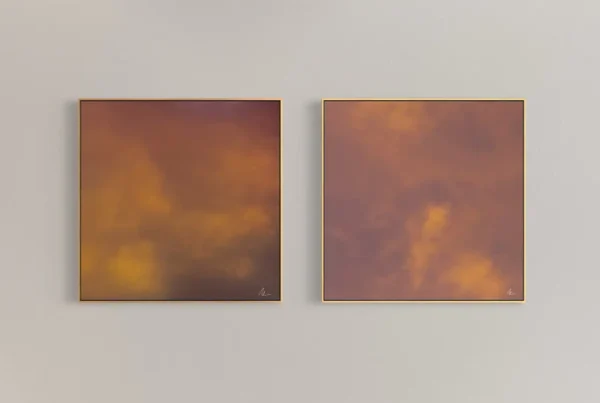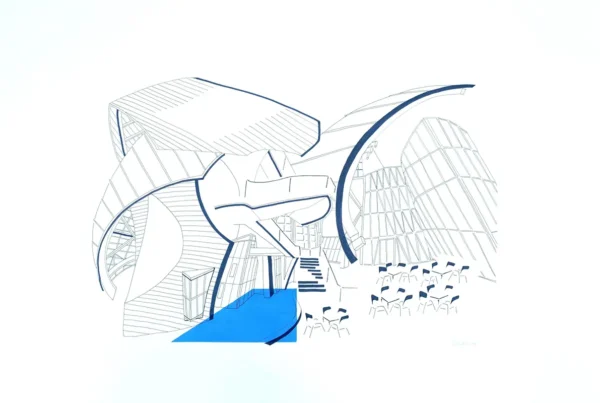“I revel in the element of surprise when I bring two things together and there is an unexpected result. I am chasing this experience in the work, while also being an investigator as I discover previously invisible histories.”
Curiosity as a Lifelong Compass
Sarah Buckius is an artist whose work is a testament to the power of curiosity. From a young age, her drive to explore and understand the world around her was evident in the way she engaged with her surroundings, building forts, creating mud pits, and observing insects and amphibians. This early fascination with the world laid the foundation for a life characterized by a relentless pursuit of knowledge. Buckius describes herself as becoming “more and more curious” with age, as each new discovery opens up vast landscapes of what she has yet to learn. This insatiable curiosity is the bedrock of her artistic practice, propelling her to continually push the boundaries of her work and explore new media and ideas.
This deep-seated curiosity led Buckius to initially pursue a career in mechanical engineering, where she found a unique intersection between problem-solving and creativity. However, her journey did not stop there. While working as a mechanical engineer, she discovered the field of Industrial Design, which sparked a new interest in the potential of combining art and technology. This realization marked the beginning of her transition from engineering to the interdisciplinary world of art, where she could fully explore the intersections of design, media, and technology. Her educational path, which includes a B.S. in Mechanical Engineering and an MFA from The University of Michigan, reflects this evolution, as she moved from the structured realm of engineering to the more fluid and expressive domain of multimedia art.
Throughout her career, Buckius has continuously expanded her artistic repertoire, delving into photography, video, performance, and more recently, animation, textiles, and sculpture. Each of these mediums allows her to express different facets of her identity and experiences, from her background in engineering to her role as a mother. Her work is a reflection of her ongoing quest to understand and represent the complex, often invisible, layers of human experience, particularly those related to gender and technology.

Sarah Buckius: The Intersection of Gender, Technology, and Art
Buckius’s artistic style is a rich tapestry of her experiences as an engineer, artist, and mother, intricately woven with themes of gender and technology. Her work is deeply rooted in her desire to support diversity, equity, and inclusion (DEI) in STEM fields. Through her art, she seeks to highlight the ingenuity of diverse groups and challenge the pervasive gender biases that exist within these domains. One of her primary goals is to make visible the often overlooked and undervalued labor of women, both in domestic settings and in the public sphere. Buckius refers to her creations as “Intertwined HerStories,” narratives that emerge from the confluence of gender, technology, and media, exploring the ways in which these elements intersect with the human body and the act of caregiving.
In her latest work, Buckius delves into the absurdity that arises when the ordered, production-based world of technology clashes with the messy, idiosyncratic nature of humanity. She is particularly interested in how the process of creating and working with technology can reveal deeper truths about human nature, including the persistence of gender biases. Her approach is one of exploration and discovery, where the unexpected outcomes of combining disparate elements become a central focus. This element of surprise is something she actively seeks in her work, as it allows her to uncover previously hidden histories and perspectives.
Buckius’s art is not just a reflection of her own experiences but also a commentary on broader societal issues. By intertwining historical and contemporary imagery, she creates a dialogue between the past and the present, highlighting the ongoing struggles and achievements of women in STEM fields. Her work serves as a visual representation of the complexities and contradictions inherent in these domains, using absurdity and collage to challenge viewers’ perceptions and encourage them to question the status quo.

The Power of Collage and Absurdity
Collage is a fundamental element of Buckius’s artistic process, allowing her to create layered, intricate works that resonate with both personal and political meaning. Her use of collage reflects her life as a caregiver, where nothing is permanent, everything overlaps, and work is often done in fits and starts. This medium allows her to bring together fragments of historical and contemporary imagery, creating new narratives that challenge traditional notions of production and order. Through collage, Buckius can explore the absurdity that often emerges at the intersection of technology and humanity, where the logical and the illogical coexist in a delicate balance.
Absurdity is another key theme in Buckius’s work, particularly as it relates to her experiences with gender bias in STEM fields. She uses absurdity as a tool to resist and critique the dominant paradigms that perpetuate these biases. By rendering elements of her work absurd, Buckius disrupts viewers’ expectations and draws attention to the illogical nature of cultural and technological biases. This absurdity is not just a reflection of her frustration with the lack of diversity in STEM fields, but also a commentary on the disconnect between the ideal of a bias-free world and the reality of ongoing gender discrimination.
In her art, Buckius often employs repetitive actions and visual patterns that, when taken to the point of absurdity, become nonsensical and abstract. This process mirrors the illogical logic of cultural constraints and technological processes, transforming real elements into referential abstractions that are both aesthetically pleasing and grotesquely beautiful. By embracing absurdity, Buckius is able to subvert traditional narratives and create works that challenge viewers to think critically about the role of technology and gender in society.

Sarah Buckius: A Vision of Collaborative and Interactive Art
Buckius’s vision for the future of her art is as ambitious as it is imaginative. She dreams of creating a large-scale interactive performance that would bring together various elements of her work, including feminist science fiction, human-computer interaction, and contemporary issues related to DEI. This project would involve audience participation, where movements are choreographed through algorithm-like instructions, creating a synchronous, abstract performance that blurs the lines between human and machine. The performance would be accompanied by multi-channel video projections, featuring animations made from altered historical and contemporary imagery, further exploring the themes of gender and technology.
This envisioned project reflects Buckius’s belief in the power of art to engage audiences in meaningful and thought-provoking ways. By combining performance, video, and interactive elements, she aims to create a dynamic and immersive experience that challenges traditional notions of art and technology. This project would also serve as a continuation of her ongoing exploration of the absurdity and complexity of the human-technology interface, highlighting the ways in which these interactions can reveal deeper truths about our society.
Buckius’s work is characterized by its interdisciplinary nature, incorporating elements of video, performance, textiles, and games to create a multi-dimensional artistic experience. She is committed to using her art as a platform to support DEI in STEM fields, and her work often engages with diverse audiences in various contexts, from exhibitions and workshops to maker’s fairs and public talks. Through her innovative use of multimedia and interactive formats, Buckius continues to push the boundaries of what art can be, creating works that are as intellectually stimulating as they are visually captivating.






